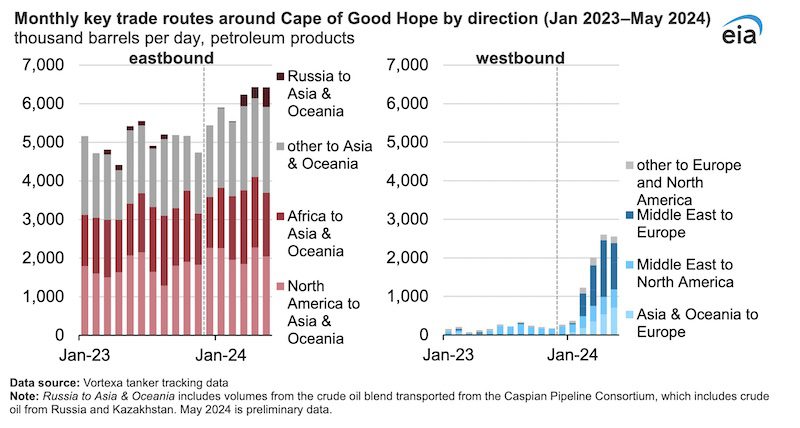search the site
Cape of Good Hope Oil Trade Surges as Tankers Reroute

Crude oil and oil product flows around the Cape of Good Hope increased by nearly 50% in the first five months of 2024 compared to last year’s average as commercial vessels avoid Middle East chokepoints, according to the U.S. Energy Information Administration.
The shift in maritime trade is the result of numerous and ongoing drone and missile attacks by the Yemen-based Houthis in late 2023, which have led many commercial ship operators to avoid the Bab el-Mandeb Strait and the Red Sea off Yemen. As a result of the reroutings, the volume of crude oil and oil products circumnavigating the Cape has risen from an average of 5.9 million barrels per day (b/d) in 2023 to 8.7 million b/d—a staggering 47% jump in a matter of months.

EIA data shows that Saudi Arabia and Iraq, key Middle Eastern crude oil producers, rerouted more crude oil westbound to Europe around the Cape rather than through the Suez Canal, accounting for 15% of the total volume increase. Meanwhile, Asian and Middle Eastern refiners boosted their oil product exports to Europe, contributing to 29% of the increased trade around the Cape.
The United States also adjusted its oil trade dynamics, receiving more Middle-Eastern and Asian crude oil and oil products and shipping more oil products to Asia via the Cape. The result has been a one-third increase, or just over 600,000 b/d, in total U.S. trade around the Cape from the 2023 average.
Meanwhile, Russia, while less affected by the Red Sea disruption, quadrupled its shipments of crude oil and oil products to Asia via the Cape, compared to 2023.

The decision to reroute vessels around the Cape of Good Hope comes at a price. Shipping times have nearly doubled, with journeys from the Arabian Sea to Europe via the Cape taking about 15 days longer than via the Bab-el Mandeb and the Suez Canal, resulting in increased costs and delayed shipments.
SOURCE : gcaptain


















